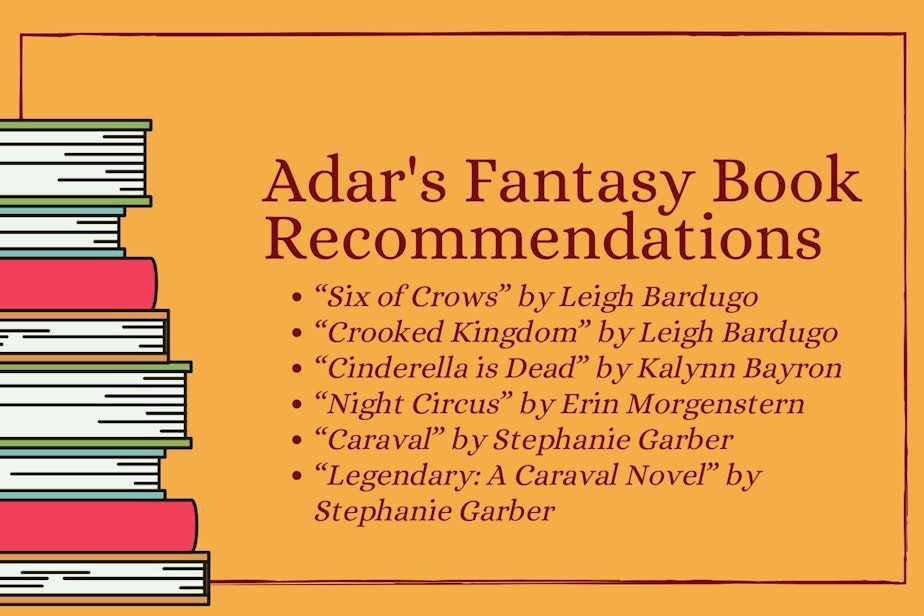Fantasy books are my escape, but I wish the genre was more inclusive
Adar Abdi is a White Center teenager who's read 68 fantasy novels over the last year. She gravitated to fantasy as an escape from reality; into worlds without racism or sexism.
But as she continued to read, she found more messages — subtle and overt — that brought the same issues she tried to avoid to the forefront.
This piece is an imagined confrontation between Adar and a fantasy writer.
[RadioActive Youth Media is KUOW's radio journalism and audio storytelling program for young people. This episode was entirely youth-produced, from the writing to the audio editing.]
The transcript below has been edited for clarity.
NARRATOR: "Shivering and shaking through the beautiful green forest, I finally noticed the bridge and I couldn’t believe what I saw next. Walking on the magical snake charmed bridge was Anime, with beautiful, milky-white skin. Her skin was as smooth as silk. She had eyes as blue as the Aladdin Ocean. She looked so fragile and feminine. If I touched her, she would shatter. She was the epitome of natural beauty. She was, without a doubt, a woman."
ADAR: Um… that was a very icky paragraph.
NARRATOR: Who are you to say that? I wrote that myself!
Sponsored
ADAR: Well, I like to call myself a fantasy book fanatic. Fun fact: Last year alone I read a total of 68 fantasy books.
NARRATOR: Wait, why do you like fantasy books so much?
ADAR: Well, it gives me an escape from reality. When I’m reading, I feel like I’m in another world. A world where there’s no racism, sexism, or any other -ism for that matter — and there’s something so magical about that.
NARRATOR: But what’s wrong with fantasy? You love fantasy, I love fantasy!
ADAR: I’ve been noticing that a lot of fantasy books have problematic issues. The same things I want to escape are exactly what I’m seeing. So many authors say the whole point of fantasy is it’s not supposed to resemble anything from our world. But if that statement is correct, then why do so many authors constantly use white skin tones to describe their characters?
Sponsored
NARRATOR: Okay, but that’s just one example.
ADAR: Or why, when authors want to include POC characters, they usually put some sort of stereotype twist? Like time and time again, the evil character or villain is someone who is either darker-skinned or has BIPOC features, and the good person is usually someone who has Eurocentric features. Like, why can’t the characters have orange skin with purple eyes?
NARRATOR: But it’s all fiction! Why does it matter?!
ADAR: Let me stop you there. I want you to remember all the fairy tales you read growing up. Did those have a direct correlation on how you perceived the world?
NARRATOR: Could you give me an example?
Sponsored
ADAR: Okay, let’s take Cinderella. She had an evil stepmother, right? Now I want you to think: At that point after watching, did you fear having any sort of stepmother because she might be evil? I know I did, and I only thought this because of the Cinderella story.
NARRATOR: Okay…
ADAR: Or how about the Bogeyman hiding under your bed? Did you fear this before you ever heard a story about the Bogeyman? Probably not.
NARRATOR: Ohhhh, I never noticed that!
ADAR: Exactly! This is why having characters that constantly have Eurocentric features is an issue. It makes it seem that beauty has only one form, and that anything that is different is ugly, in a way. If all the attractive people in fantasy books only have Eurocentric features, what are people who don’t have those features going to think about themselves? People are going to think beauty automatically equals whiteness.
Sponsored

NARRATOR: That makes a lot of sense, but now I feel like basically all fantasy books have this in their writing. What am I supposed to do now?
ADAR: Well, I want you to know you can read books that have great representation, as well as an amazing plot! I loved the vibe of your fantasy paragraph in the beginning, but I think you can add some spice. Maybe take some of what we talked about today, and put it in your writing.
NARRATOR: Okay, how about this? “Shivering and shaking through the beautiful, green forest, I finally noticed the bridge, and I could not believe what I saw next. Walking on the magical snake charmed bridge was Anime. She had magnificent lavender skin that was so glowy. The color of her eyes will be forever engraved in my brain. It was this bright, amber color. She truly looked beautiful. She looked out of this world."
ADAR: I love that!
Sponsored
This RadioActive Youth Media podcast was produced in an advanced producers program for high school and college students. Production assistance and prepared for the web by Mary Heisey. Edited by Ann Kane. "Narrator" was voiced by Zaki Hamid.
Find RadioActive on Facebook, Twitter, Instagram, TikTok, and on the RadioActive podcast.
Support for KUOW's RadioActive comes from the Bill & Melinda Gates Foundation Discovery Center.
If you have any feedback on this story, you can email RadioActive at radioactive@kuow.org or find RadioActive on Twitter @kuowradioactive. Or you can just click the feedback button on the right hand side of this page. Reach out. We're listening.



